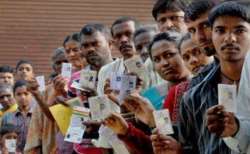Mystique behind multi-phase polls
Extended elections in multiple phases allow political parties and formations malleability and ductility.

An important characteristic of multi-phase elections is the traction the political rhetoric gets. Extended elections in multiple phases allow political parties and formations malleability and ductility. Size is obviously the biggest determinant in such an exercise for Indian states are vast with different kinds of topography. Analysts point out the high stakes: the game is afoot for 220,000 polling booths across the country.
The polarizing potential of incendiary statements and the resultant divisiveness are amplified over a prolonged period, whose consequences are evident when the results are out. A case in point is the controversial statement of BJP leader Dayashanker Singh, whose sulphurous invective against Mayawati during the 2017 Uttar Pradesh assembly polls led to a furore. High-profile BJP leaders had remained largely silent as chastising such leaders publicly would have demoralized the cadre. Such kinds of outbursts are commonplace in Hindi heartland and are used to galvanize cadre and voters.
Then, there's the question of law and order. The Naxal angle, for instance, cannot be ignored. Nor the communal incidents, which political parties and partisan politicians use to polarize themes. Messaging and communication stratagems still work as they did during the protracted UP assembly polls. Fractiousness brought about by such incidents influence voters, one can argue, more in urban agglomerates than in rural areas. The non-committed and the less committed can well be swayed by communal incidents or by results of, say, even local body polls.
Lumpen elements, the ‘mahabalis' and the ‘bahubalis' (the musclemen) also need to be controlled and bottled. That is why the Election Commission is using the gambit of multi-phased elections in states where violence is feared during polls.
Yet, multi-phase polls give parties an opportunity to reassess, regroup and revise their strategies for different phases. Throw in some word-of-mouth from on-ground cadre to jump-start both lazy and active voters, and you have a successful operation going.